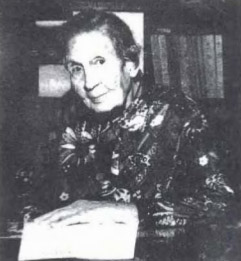Maria Isabel Hylton Scott facts for kids
Quick facts for kids
María Isabel Hylton Scott
|
|
|---|---|
 |
|
| Born | August 16, 1889 Córdoba, Argentina
|
| Died | September 1, 1990 (aged 101) La Plata, Argentina
|
| Citizenship | Argentina |
| Known for | described 1 family, 47 species and 4 subspecies of Mollusca |
| Awards | Honorable medal on the 100th anniversary of the Museo de La Plata, Honorary Member of the Asociación Argentina de Ciencias Naturales. |
| Scientific career | |
| Fields | zoology, malacology |
María Isabel Sofia Hylton Scott y Pacheco (born August 16, 1889, died September 1, 1990) was an amazing Argentine scientist. She was a zoologist, which means she studied animals. She was also a malacologist, focusing on mollusks like snails and clams. María Isabel was a teacher too. She made history as the first woman in Argentina to earn a doctorate degree in Zoology. She discovered and described many new types of mollusks, including at least 1 family, 47 species, and 4 subspecies.
Contents
Early Life and Education
María Isabel Hylton Scott was born in Córdoba, Argentina, on August 16, 1889. She went to the Normal School and became a teacher in 1908. Later, she continued her studies at the National University of La Plata. In 1911, she earned a degree as a professor in Pedagogy. She learned a lot from Dr. Miguel Fernández and his wife, Dr. Katy Marcinowsky-Fernández. They helped her with her first science projects.
Becoming a Zoologist
In 1914, during the start of World War I, María Isabel began working. She was an assistant in the Zoology laboratory at the Museo de La Plata. This was a big step in her scientific career.
Just two years later, in 1916, she achieved something special. María Isabel became the first woman in Argentina to get a doctorate in Zoology. Her important research focused on the development of a freshwater fish called Fitzroyia lineata. This fish is now known as Jenynsia.
Scientific Career and Discoveries
María Isabel worked as the head of the laboratory until 1924. She also taught as a substitute professor from 1933 to 1946. She returned to teaching in 1955. Her university work was sometimes paused because of political changes in Argentina.
She loved to travel for her research. In 1916, she visited Puerto Madryn. Later, in 1936, she went to Santa Cruz with her husband, Max Birabén. These trips helped her study different animals.
Founding a Science Magazine
In 1954, María Isabel and her husband started a science magazine. It was called "Neotropica - Notas Zoologicas Americanas". They worked on editing this magazine until 1976. Even today, Neotropica is an important magazine for mollusk studies.
María Isabel retired in 1965 when she was 76 years old. She moved to Buenos Aires with her husband. He became the director of the Museo Argentino de Ciencias Naturales. Even after retiring, she kept doing scientific research. From 1977 to 1984, she published five new scientific papers.
Later Life and Legacy
In 1977, when María Isabel was 88, she received a special award. It was an honorable medal for the 100th anniversary of the Museo de La Plata. In the same year, she was made an Honorary Member of the Asociación Argentina de Ciencias Naturales. This recognized her important contributions to science.
When she turned 100, María Isabel Hylton Scott made a generous gift. She donated her personal collection of mollusks to the Museo de La Plata. This collection is very valuable for future scientists.
María Isabel Hylton Scott passed away on September 1, 1990, in La Plata. After her death, she was honored again. She was named Honorary President of the 1st Latin American Congress on Malacology in 1991. Her work continues to inspire many scientists.
Images for kids
See also
 In Spanish: María Isabel Hylton Scott para niños
In Spanish: María Isabel Hylton Scott para niños


